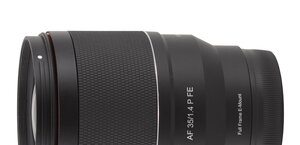Sigma C 30 mm f/1.4 DC DN
3. Build quality
It’s worth noticing how much you can gain if you decide to construct a lens for smaller sensors. The Leica DG Summilux 25 mm f/1.4 ASPH., despite the fact that it has the same amount of elements and groups, is noticeably smaller and lighter than the tested Sigma, allowing you also to employ filters with a smaller diameter.
In the photo below the tested lens is positioned next to two full frame 35 mm devices: the Sigma A 1.4/35 and the Canon EF 2/35 IS USM.
Please Support UsIf you enjoy our reviews and articles, and you want us to continue our work please, support our website by donating through PayPal. The funds are going to be used for paying our editorial team, renting servers, and equipping our testing studio; only that way we will be able to continue providing you interesting content for free. |
- - - - - - - - - - - - - - - - - - - - - - - - - - - - - - - - - - - - - - - - - - - - - - - -
 |
The Sigma C 30 mm f/1.4 DC DN starts with a metal mount which surrounds a contact plate. Its rear element, 22 mm in diameter, doesn’t move and is hidden inside a nicely blackened and ribbed tube. There are no slits so the construction seems to be entirely sealed from this side; dirt and dust won’t invade the interior of the lens.
 |
The proper casing of the Sigma starts with a small ring made of plastics on which there is a white dot making an alignment with a camera easier. Then you see the name and the parameters of the lens, the Micro 4/3 system logo and the serial number.
Next ring, also immobile, is already made of metal; it features a “C” letter meaning the lens is classified as a “Contemporary” series device, the autofocus working range (0.3M/0.98FEET–∞), the year of production (016) and information that the lens was made in Japan.
 |
A manual focus ring is undoubtedly the biggest part of the lens. It is as wide as 38 mm and most of its surface is ridged for firmer, more comfortable grip. Unfortunately you can’t find any distance scale or depth of field scale on it. The ring is a direct drive device and running through the whole scale needs a turn through an angle of about 220 degrees. That value, however, changes with the turning speed.
 |
Right behind the manual focus ring you see a mount for a circular hood which is added to the accessory kit. The front element is 33 mm in diameter and it doesn’t move. It is surrounded by an inscription stating the name and the parameters of the lens along with a non-rotating filter thread, 52 mm in diameter.
 |
Buyers get both caps and a hood in the box.
 |






